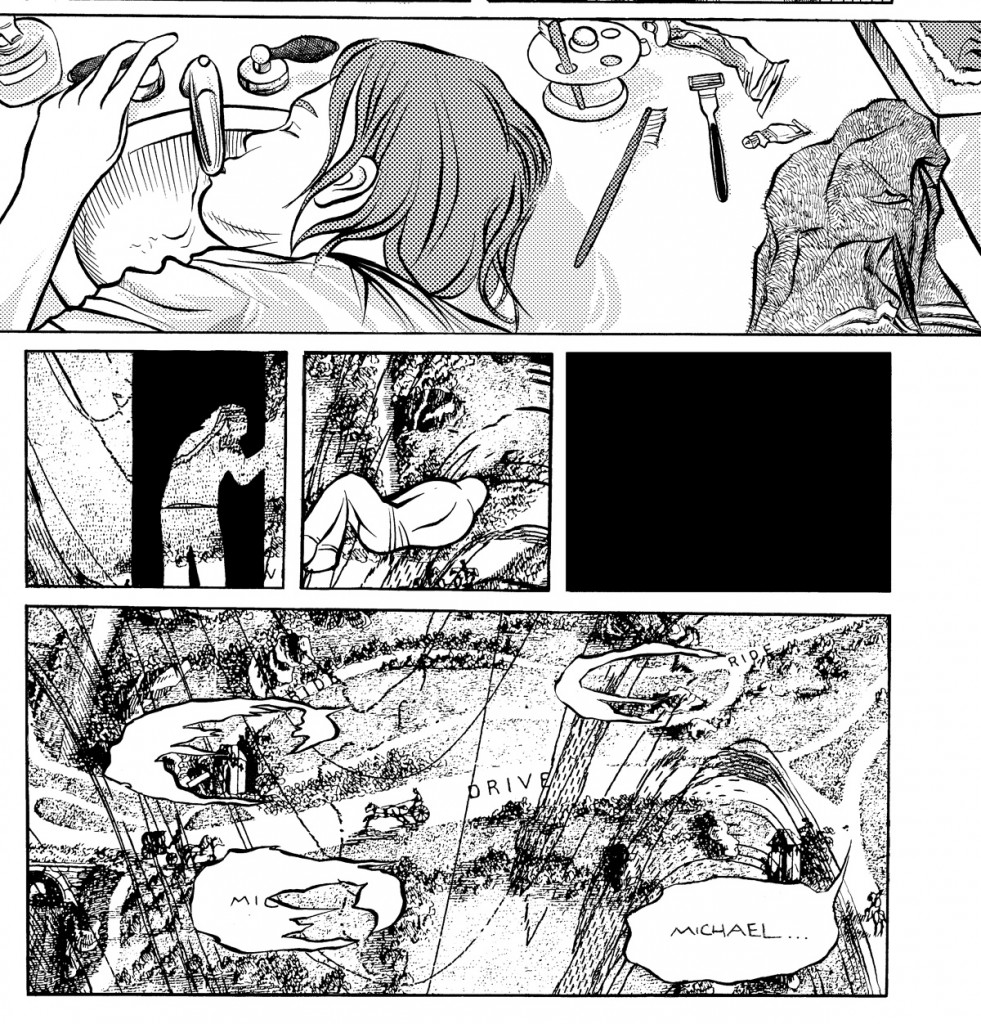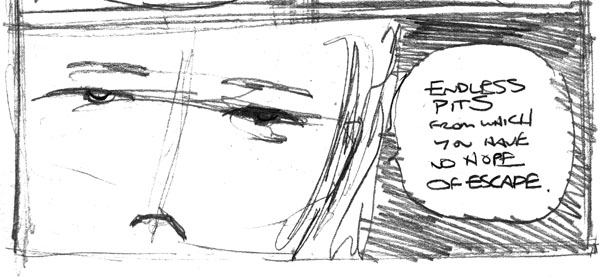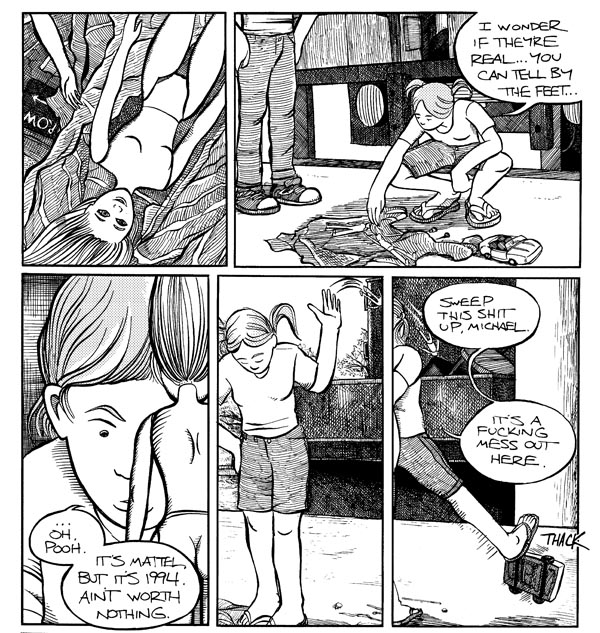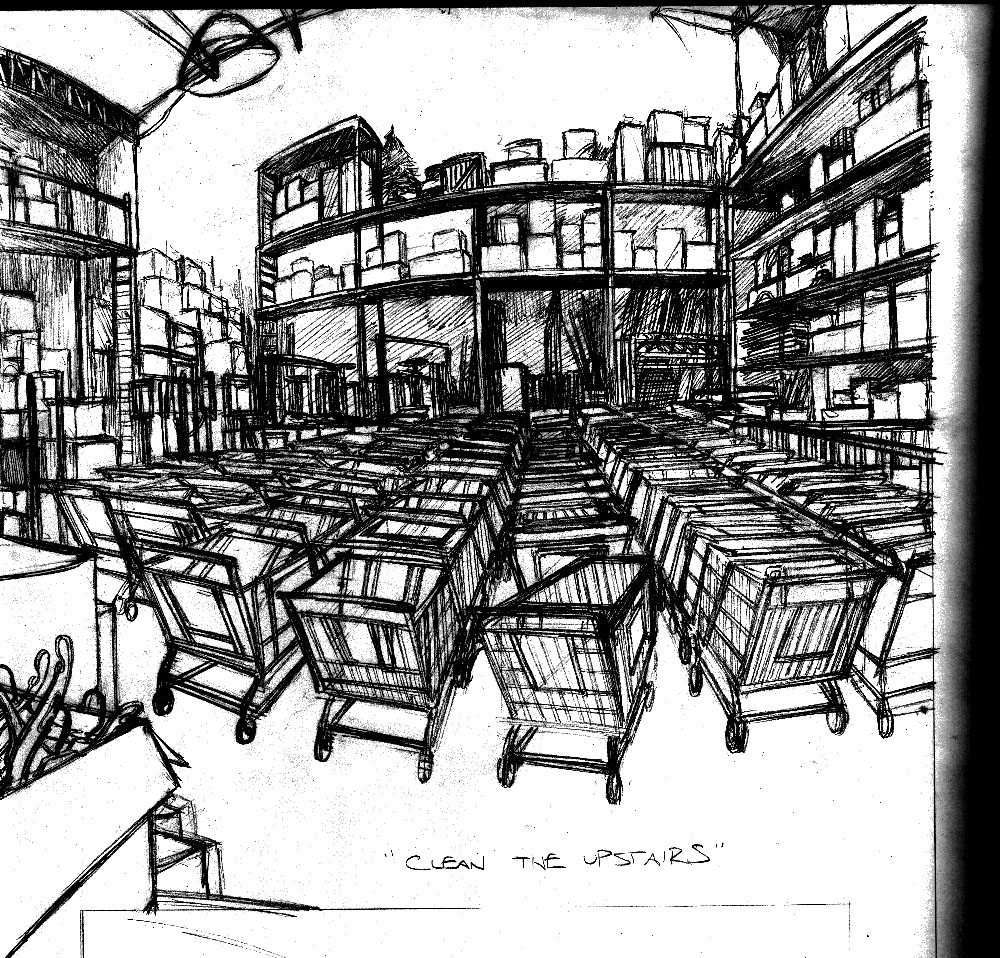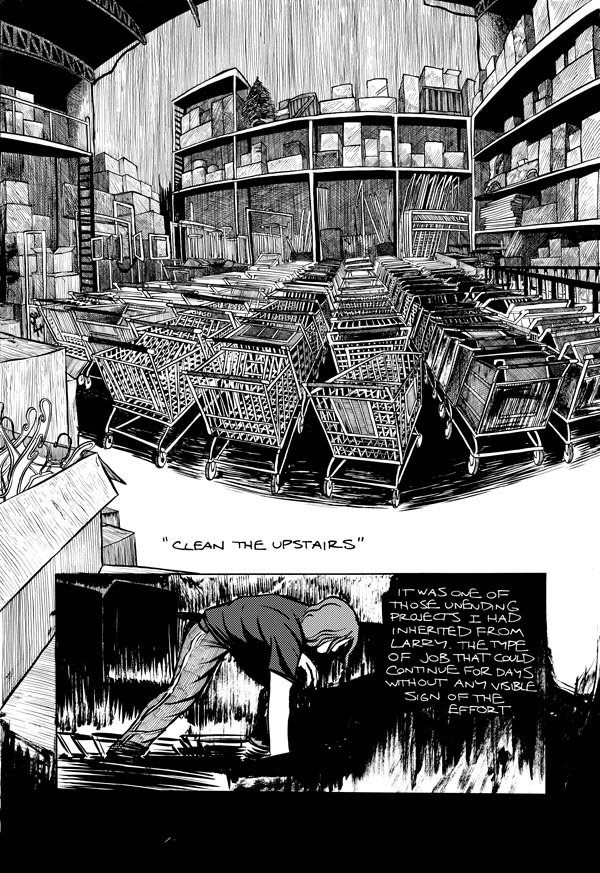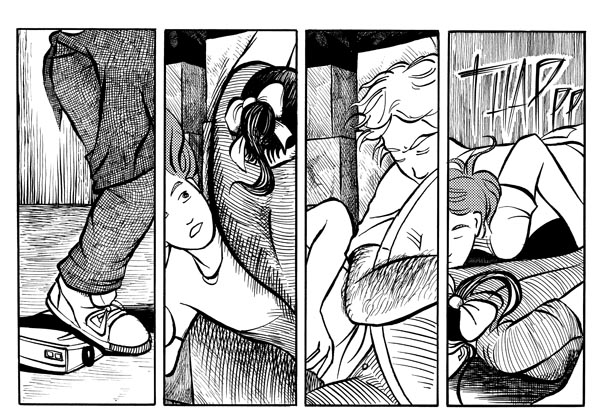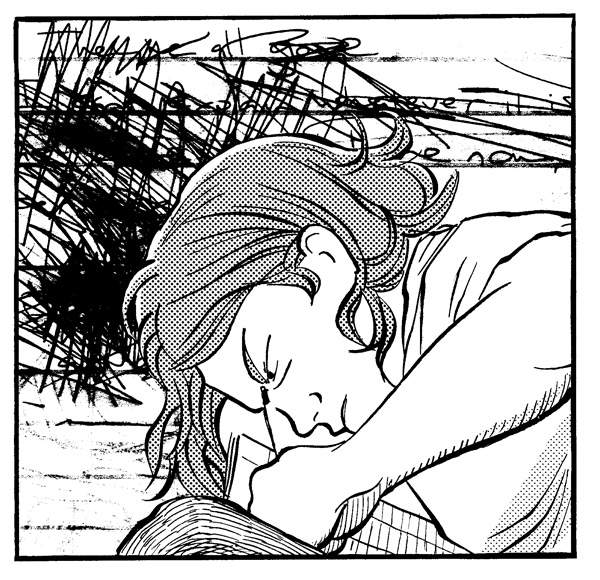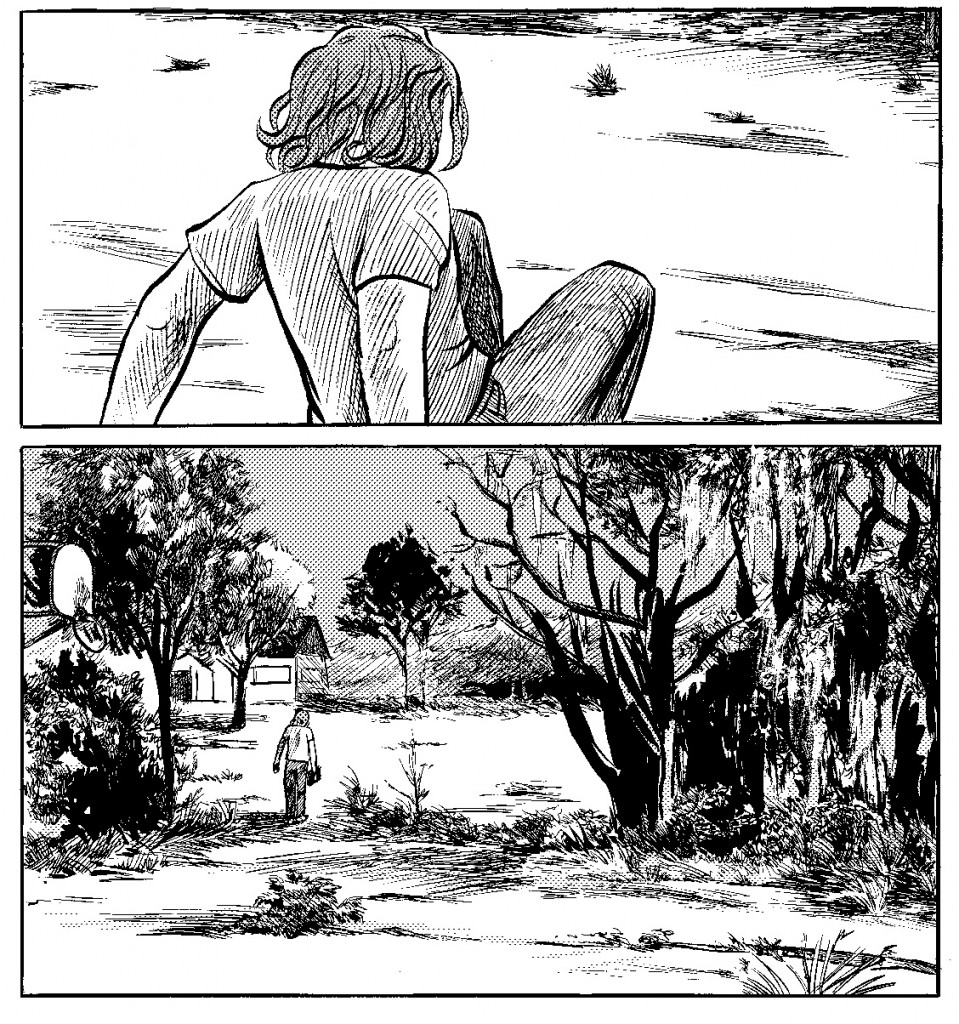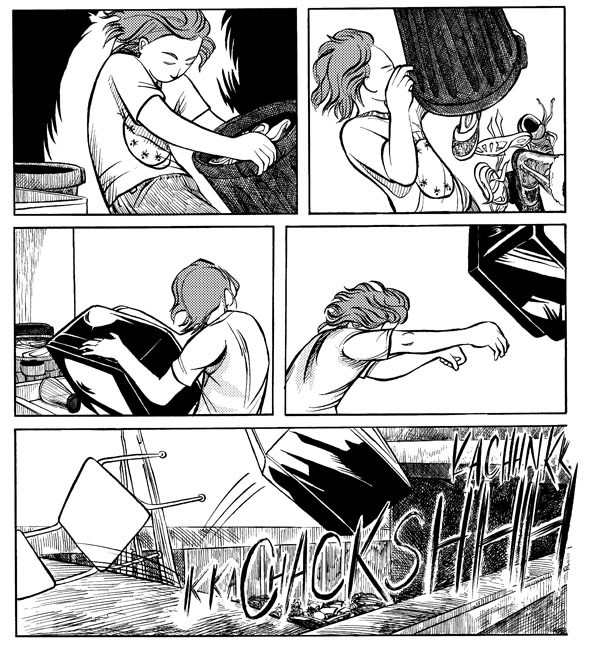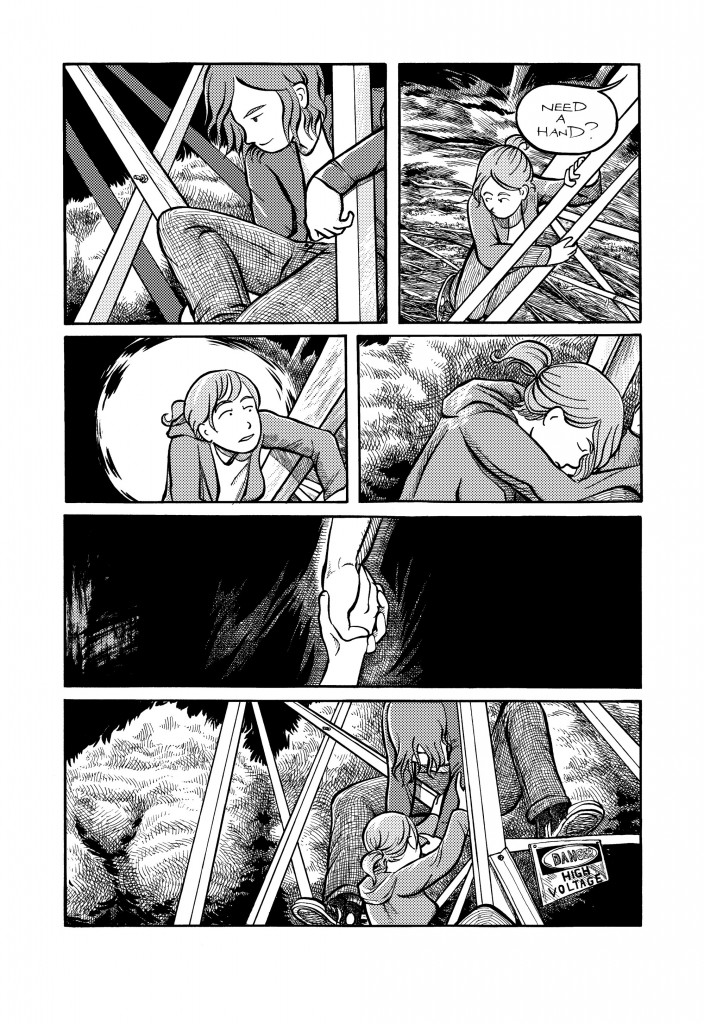Every once in a while I’ll get an email from someone who wants to know. “Whatever happened to that graphic novel you were working on? Did you ever finish?”
Discards. I worked on it for four years, completed more than three hundred pages while working full-time as a high school art teacher. And now it sits in a box in my closet, unread by all but a few friends, several of whom largely hated it.
What went wrong?
I’m still a teacher. I look at the pile of effort and time and in the right light I see something that might be useful to another cartoonist. I did after all make it that far. Hundreds of pages of finished comic art is in itself nothing to sneeze at. And there’s no doubt in my mind that those hundreds of pages, along with my high school teaching, brought me the skills that I have today, skills that employ me as a freelance illustrator, even if my cartooning itself isn’t in much demand these days.
I was twenty-six when I started, a high school teacher with an almost fevered desire to work, to make things, to bury myself in the aspects of my life I could control. For several years, making Discards provided me with the focus I needed to forget all the other things in my life that were making me miserable.
But somehow, of all the projects I’ve been involved in, this was the one I was unable to drag across the finish line. What went wrong?
But first —
What Went Right
There are reasons I got as far as I did, things I did that I would recommend to anyone pursing long-form comics. For one, I wrote a script — multiple drafts, in fact. The story started out as prose, a manuscript called The Three Thrift Kings. On second revision it lost its title along with most of the text, and became Discards.
The first draft was a loosely interconnected set of stories largely set at a thrift store in rural Florida. The protagonist Michael (I know, I know) has returned to his childhood home for unspecified reasons and takes a job as a janitor at a thrift store. It’s a sort of Pilgrim’s Progress, in a retail outlet, with drugs and lots of monologues about video games.
As a first draft, the story was a structural mess. I had written it as a receptacle for a series of autobiographical anecdotes about my time as a janitor, back-up man, and finally furniture-electrical pricer at a large thrift store in Casselberry Florida. The smaller nested anecdotes were stories I had refined over a long period of story-telling, but the central plot that linked them all together had been grafted on later in the process. (This too was a “found” element. After talking with a fellow teacher about all the strange things I had encountered working at the store, he told me about one of the strangest jobs he had ever worked — cleaning out evicted properties. His story of finding a stash of drugs, and the subsequent return of the owner of said drugs, would provide the missing through-line necessary to make a coherent story out of first draft.)
The second draft refined the physical environment of the story until it took place in essentially two locations– Michael’s house, the thrift store, and the walk between the two. It also strengthened the main events of the narrative by introducing those strands of plot earlier on. In short, it was structurally sound, something that would have been impossible to do had I tackled the pages graphically directly from the onset.
The setting for the story was visually rich as well, and I knew that my intimate knowledge of the minutia of the environments I would be describing would make for interesting comics.
After completing the second draft of the script, I made my second smart move – I drew layouts for the entire book.
Years of studying page mechanics, and the two or three hundred pages I had drawn in my life so far, meant that the layouts came easily, once I warmed to the task. After some initial slowness, I worked my way up to a speed of about 20 pages of layouts a day, working on sheets of discarded paper folded in half, mainly to discourage myself from feeling too precious about my drawing.
In fact, the faster I worked, the better things seemed to go. If I got bogged down on a page, trying to figure out the spacial mechanics of a scene or movement of the characters or placement of dialogue, I’d just crumple it up and continue on another sheet. After a few days of this my layouts were getting much stronger, even as my drawing itself got looser and looser. By the end of the month I had laid out the entire 400 page book.
Not having a final length in mind led me to expand and contract sections at my own whim, and I brought an almost perverse joy to extending certain sequences that had in the script been only a sentence or two of description. Other scenes were recast dramatically, especially dialogue-heavy scenes, which often had added physical action as my “actors” took over from my writer.
And if this were a happy article about personal fulfillment and artistic success, this might be where I would end, with the satisfied artist and his stack of folded copy paper, a readable story in his hands mere months after first imagining.
But I’m afraid that’s not what happened.
What Went Wrong
What am I looking at, and why do I care? Discards, page 25
A. Millions of Tiny Little Lines/ Working Too Large
When I started Discards, I had some experience in pen and ink, with a wide variety of tools and textures at my command. But I had virtually no experience working for reproduction. By the time I had drawn my first 50 pages, it was clear two things were already very wrong.
For one, I was working at a scale much too large to be useful for me. Specifically, I was working with an active page area of 11” x 15”, i.e. double the size of my folded letter-paper layouts. Huge originals plus a mania for tiny little lines and an initial fear of bold application of blacks equaled pages that seemed anemic and washed-out, no matter how many layers of lines I added.
And all those little lines added precious time to each page. My work sessions took place every day after ten hours of teaching. I timed them. Each page was taking between 10 and 15 hours to complete, the majority of this time spent embellishing. “Well, you’re fearless, aren’t you?” cartoonist Jim Woodring told me once, staring at a page consisting of nothing but shopping carts in a darkened room. I don’t think he meant it as a compliment.
B. Shifting Designs
Even worse than the huge amounts of largely invisible effort was the waste caused by ineffective designs or “off-model” characters.
Somewhere, some when, some genius said it first. “In comics, style is way less important than consistency.” Whomever it was, I’d like to shake their hand, and then ask them to please build a time machine and head over to Seattle circa 2009 so that they can let me know in person.
My initial designs for my characters just weren’t very well-thought out. They weren’t easily distinguished from each other, not by body type, not by facial structure. And as a consequence of that initial failure, I just kept on tweaking even as I produced “finished” pages.
The result of this was a stylistic mishmash, where characters were sometimes only identifiable by the type of screen-tone applied to their hair. Had I applied some basic rules of design to differentiate them from each other at the start, it would have saved me a lot of grief.
This “design drift” was made even worse by the rudimentary nature of my cartooning. As an observational draftsman, I had some skills to draw upon at the start of the project, but as a cartoonist producing stylized forms from my imagination, I had a lot of work to do. And the better I got at these tasks, the more inadequate the previous pages seemed to my eye.
The crudity of the drawing was made worse by the surface polish of the inking and rendering.
Sylistic drift of this kind would have to be very dramatic to be visible over the time scale of, say, a ten page or even 25 page story. But a graphic novel is one contained unit. You can hold it in your hand, flip through it, stick your fingers between the pages. The first panel exists with the last in perfect simultaneity, no matter how much time passed in the process of creation.
This is not unlike the difficulty of assessing the work of, say, Dave Sim and Gerhard and their 26-year project Cerebus. The early issues of Cerebus, crude as they could be visually, still stood unified stylistically as they appeared, issue by issue. But as collections, the early work reads very differently. Much of this difference is undoubtedly due to this stylistic drift. What was an asset in the serial format (improvement of the artist over a prolonged period of time) becomes a liability when the format is changed.
Had I been publishing or otherwise making these portions of Discards publicly available as I worked, it’s possible that I would have been able to make peace with the early portions of the book. But as it was, unseen by anyone save my fellow Seattle cartoonists, the early pages shortly seemed unbearably crude to my eyes. And the more I developed, the wider the “awkward” phase of the book seemed to be.
“Be like a shark,” cartoonist Jon Morris tried to warn me. “A drawing shark. Don’t stop swimming. Just keep eating stuff.” And had I been working on a series of short stories, something where each unit could be its own contained unit, then I might have persuaded myself he was right. But this was a novel, dammit. Shouldn’t the first page look like the last?
C. Didn’t You Know What A Jerk You Used to Be?
The real end to all of this wasn’t my frustration with my drawing, or the labor of the large-format pages. I actually managed to correct course on both of these problems mid-way through the book, switching to a much smaller scale, working with more dramatic blacks and incorporating bold brush into some pages, and finally settling in to drawing the characters with an acceptable amount of consistency.
What finally sunk it was this – so much time had passed since the initial idea, I hated the whole story.
It was two cartoonist friends of mine, David Lasky and Helen America, that gave me the bad news that I was making a book about an asshole. He’s completely unlikable, they each told me over tea and cake. Why should we care about him at all?
This was a hard blow. I was, after all, in the process of making a story about someone who possessed many of my memories and experiences, if not always my actions or personality. How could they say something so harsh about him? About me?
And then, with their reactions in mind, I sat down and read what I had made.
I hated him.
Really, I hated me.
Here was a story about someone who is essentially a tourist in the lives of the people around him, who observes them from the comfortable distance of condescension. Several of the choices I made as a cartoonist reinforced these distances – the facial caricature, the dialect. Here, truly, was a book about a brash young man who is in fact an asshole. Who happened to have been based, at least partially, on myself.
I tried a few fixes, specifically, adding a sequence in the very beginning that gives the character some self-awareness of these deficiencies, letting the audience into his thought process a bit while introducing hints as to the events had shaped him into the person he was.
But it was too little too late. The project was definitively killed a month or two later, when I had my first taste of being paid to make things I was interested in. My labor was done, although Discards never would be.
What’s The Point Here, Anyway?
When I think about my brief time making comics for public consumption, I’m struck by the oddity of it all, that my most widely-read comic written and drawn in a single twenty-four hour period, was not labored over in any way at all. How different would my cartooning have been if I had used all the time I spent on Discards making other short, spontaneous comics instead? How many thousands of pages might I have now had I focused on content rather than the pursuit of some awkward perfection?
Of course, who knows what those comics that never were might have been like, and what kind of things they might have said about who I was at that time. Although the unfinished things in our lives can be painful, in some ways it’s the finished ones that are the worst, in that our failures are so clearly articulated by our own labors.
For me, finally, I’m happy for Discards to finally be what it is, a journeyman work in a box in a closet. A personal example of what can happen when you want too much and know too little. And, maybe, an example of how not to make a graphic novel.
Sean Michael Robinson is a writer, illustrator, and musician. You can contact him at LivingtheLine.com, or at seanmichaelrobinson at gmail dot com.


